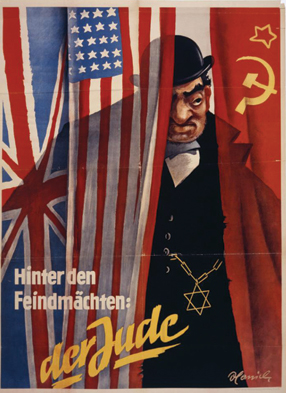
In conjunction with the State of Deception: The Power of Nazi Propaganda exhibition at the National Archives, the Midwest Center for Holocaust Education will offer a speaker series twice a month on Wednesday evenings. These events are offered in partnership with the National Archives and the National World War I Museum. The first event will be held July 9. All programs will be held at 7 p.m. at the National World War I Museum. The exhibit, which is at the National Archives in Kansas City, Mo., may be viewed prior to the speaker series
from 5:30 to 6:30 p.m. A light reception will also be available at the National Archives during that time. There is no charge for the programs or for these receptions. It is important to note that the speaker series is at a different venue than the exhibit.
Cocktails and small plates will be available for purchase at the National World War I Museum from 6 to 7 p.m. preceding each program.
“I’m very pleased with the way the speaker series came together,” said MCHE Executive Director Jean Zeldin. “We are approaching the content of the exhibition from a variety of perspectives including relevance to our world today.”
Reservations are requested for all programs and receptions by calling 816-268-8010 or emailing .
A listing of the complete series follows:
• July 9 — The Jewish Enemy: Nazi Propaganda During World War II and the Holocaust
Dr. Jeffrey Herf, distinguished professor at the University of Maryland, explores the language and metaphors that conveyed the ideological and emotional aspects of Nazi ideology, especially radical anti-Semitism, addressing the question of why centuries-old anti-Semitism assumed genocidal proportions between 1941 and 1945.
• July 23 — Building the Racial State: Nazi Propaganda and the National Community in Germany
Dr. William Meinecke, a historian at the United States Holocaust Memorial Museum, examines how Nazi propaganda shaped German society and prepared the population to accept, support or participate in persecution, war, and the mass murder of Europe’s Jews and others.
• Aug. 6 — Hate Mail: Anti-Semitism on Picture Postcards
Salo Aizenberg, a leading collector of Judaica picture postcards, presents postcard images collected largely from the pre-Holocaust era that illustrate deep-seated attitudes of society and the many virulent permutations of anti-Semitism eagerly exchanged by millions of ordinary people, beginning in the late 1800s and still pervasive today.
• Aug. 20 — Media, Reeducation, and the German Public after the Holocaust
Dr. Robert Williams of the Mandel Center for Advanced Holocaust Studies at the United States Holocaust Memorial Museum, will assess the ways that Soviet and American propaganda curtailed discussion and remembrance of the Holocaust during the early Cold War in Germany.
• Sept. 3 — World War I Posters and Visual Culture
Dr. Pearl James of the University of Kentucky situates World War I propaganda posters within the larger visual culture of the time, illustrating how a single image moved from newspapers to posters and into animated film, signaling a historic shift in warfare while changing the style of advertising and extending its reach in ways that anticipate our current, super-saturated media environment.
• Sept. 10 — Power of Film Images and the Holocaust
Sharon Pucker Rivo, co-founder and executive director or the National Center for Jewish Film at Brandeis University, presents an analysis of film propaganda — newsreels, documentary and narrative films — employed by the Third Reich in its campaign of genocide against the Jewish people, with emphasis on the importance of understanding the enormous power of the moving image. (Date changed from Sept. 17.)
• Oct. 1 — State Control and State Engagement with News Media: From the Nazis to Edward Snowden
Art Brisbane, former publisher of The Kansas City Star, explores the spectrum of state influence over news media, from outright propaganda to subtle negotiation between government and news outlets.
• Oct. 22 –– Trial of the Propagandists
Professor Harry Reicher, University of Pennsylvania Law School and scholar in residence, Touro College, Jacob D. Fuchsberg Law Center, examines the postwar trial of the major war criminals at Nuremberg, which included the first confrontation in an international court of the role of propaganda in inciting hatred. The judgment paved the way for major atrocities falling within the legal definition of Crimes Against Humanity, a notion reflected in the statutes of all major modern courts and tribunals trying egregious atrocities and adopted by the United Nations General Assembly in the 1948 Genocide Convention, which stated that “direct and public incitement to commit genocide” is a crime.